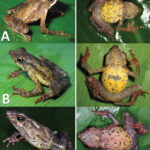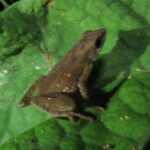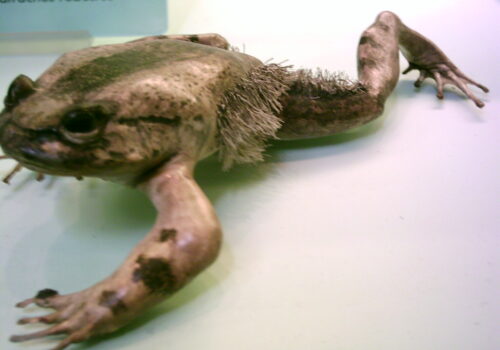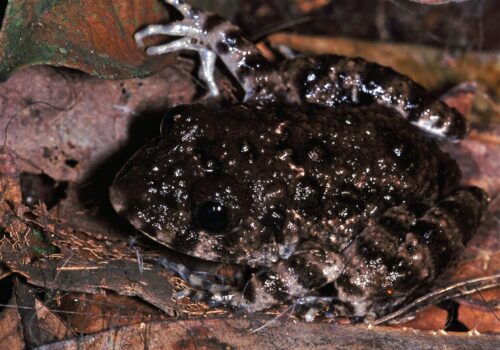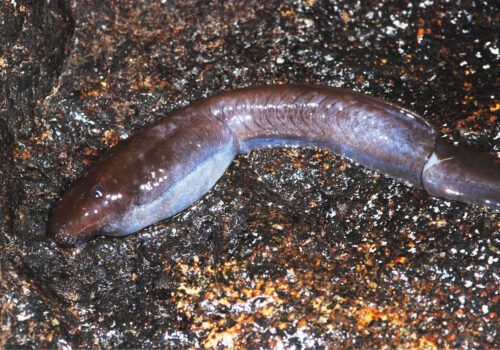- Exploring Ethiopia's Cinnamon Tree Frog: The Fascinating Life of <em>Leptopelis cynnamomeus</em>
- Taxonomy and Classification
- Natural Habitat: Ethiopia's Hidden Forest Realms
- Physical Characteristics: Nature’s Elegant Acrobat
- Behavior and Life Cycle: A Nocturnal Symphony
- Ecological Significance: Invaluable Forest Dwellers
- Threats and Conservation Status: Safeguarding the Cinnamon Jewel
- Cultural and Scientific Importance: Bridge to Understanding
- Conclusion: Preserving a Fragmented Symphony
Exploring Ethiopia’s Cinnamon Tree Frog: The Fascinating Life of Leptopelis cynnamomeus#
In the lush, verdant woodlands of Ethiopia, hidden beneath the verdant leaves and moist shadows of highland forests, lives a creature as fascinating as it is elusive. Leptopelis cynnamomeus, known commonly as the Ethiopian Cinnamon Tree Frog, conjures imagery as vivid as its name suggests—small amphibians clad in striking cinnamon hues, quietly revealing themselves against the vibrant greenery of their habitat. Established and named scientifically by Bokermann in 1964, this ethereal amphibian embodies both the fragility and resilience of its forest homes.
With wide, expressive eyes and powerful limbs finely tuned for a life swinging gracefully among dew-laden leaves, the cinnamon tree frog offers a captivating glimpse into the hidden realms of Ethiopia’s biodiversity. Beyond their beauty, these nocturnal climbers serve as critical ecological indicators for the health of their delicate habitats. Living quietly amid moss-rich tree trunks and damp-floored cloud forests, they signal subtle yet crucial messages about environmental vitality we might otherwise overlook.
Taxonomy and Classification#
Leptopelis cynnamomeus, commonly referred to as the Ethiopian Cinnamon Tree Frog, belongs to the family Arthroleptidae, an illustrious family grouping known for their adaptability and unique ecological contributions. Within this family, the genus Leptopelis is notable for its arboreal lifestyle, encompassing numerous tree-dwelling frog species distributed throughout Sub-Saharan Africa.
This particular cinnamon-colored wonder shares biological kinship with other tree frogs within the genus characterized by large protruding eyes, adhesive toe pads suited for their arboreal lifestyles, and vocal males producing melodious nocturnal calls. Together, these frogs play instrumental roles in regulating insect populations, keeping their ecosystems balanced and healthy.
Natural Habitat: Ethiopia’s Hidden Forest Realms#
Geographical Distribution#
Leptopelis cynnamomeus is endemic to Ethiopia, inhabiting the high-altitude forested areas of the Ethiopian Highlands—a biodiversity hotspot renowned for its remarkable endemism. The species is found predominantly at altitudes ranging between 1,500 and 3,000 meters above sea level. This altitude specificity highlights their reliance upon specific climatic conditions characterized by consistent humidity, moderate temperatures, and ample precipitation.
Preferred Habitats and Microhabitats#
Inhabiting montane evergreen forests, these frogs thrive amid dense foliage, shaded moss-covered branches, and damp forest floors. Highly reliant upon moisture-rich environments, they are often found near trickling streams, wetlands, and seasonal pools which serve as crucial breeding areas. The structure of their natural habitat—with layers of vegetation and an abundance of leaf litter—provides essential cover, ideal breeding grounds, and ample hunting opportunities.
The cinnamon tree frog’s presence is often an indicator of environmental stability, as this frog requires pristine, minimally disturbed habitats, making its population health a valuable gauge of broader forest ecosystem integrity.
Physical Characteristics: Nature’s Elegant Acrobat#
Size and General Appearance#
A diminutive amphibian, the cinnamon tree frog typically measures between 30 to 50 millimeters in length, with females generally slightly larger than males. Their slender build is adapted superbly for climbing, and their robust, muscular hind legs enable them to leap impressively from branch to branch.
Coloration and Patterns#
Their striking cinnamon color, from which they derive their common name, varies from rich reddish-brown shades to lighter, golden-brown hues. Such adaptive coloration helps camouflage these tiny hunters among the bark, leaves, and moss-covered surfaces of their high-altitude forests. This cryptic coloration provides essential protection against potential predators and allows them to quietly stalk prey.
Adaptive Features for Arboreal Life#
One of their most prominent features is their developed toe pads. These enlarged adhesive pads enable cinnamon tree frogs to maneuver gracefully among slippery, rain-soaked foliage, ascending vertical surfaces with astonishing agility. In addition to these adaptations, their large eyes, perched prominently on their heads, grant them excellent nocturnal vision, crucial for nighttime foraging and predator avoidance.
Behavior and Life Cycle: A Nocturnal Symphony#
Nocturnal Behavior and Feeding Habits#
Primarily nocturnal, Leptopelis cynnamomeus emerges under cover of darkness, engaging in solitary hunts among the forest’s layers. This nighttime behavior minimizes competition, reduces predation risks, and aligns feeding activities with peak prey availability. Their diet consists mainly of insects, spiders, and other small arthropods, which they capture using rapid, precise tongue strikes combined with their stealth and camouflage.
Mating and Breeding Rituals#
In the subtle shadows of the rainy season, the forests echo with the rhythmic, gentle calls of male cinnamon tree frogs. These mating calls, a hallmark of the species, serve the dual purpose of attracting receptive females and asserting territorial boundaries among competing males. Vocal displays, usually emitted from elevated perches near water bodies, allow the males to broadcast their suitability to potential mates.
Once paired, the female deposits clusters of gelatinous eggs carefully attached to leaves, branches, or directly in shallow water sources, often ephemeral pools. The developing tadpoles swiftly hatch and navigate their aquatic childhood, rapidly maturing in these shallow aquatic nurseries. Eventually, fully transformed juvenile frogs emerge and ascend into the arboreal habitats above, beginning their cyclic lifestyle anew.
Ecological Significance: Invaluable Forest Dwellers#
The Ethiopian Cinnamon Tree Frog holds critical ecological roles within their montane forest habitat. As insectivores, they actively control insect populations, balancing the local ecosystem and reducing the spread of insect-borne diseases. Simultaneously, they serve as essential prey items for larger predators such as snakes, birds, and mammals, fitting neatly within the ecological web of the Ethiopian Highlands.
Perhaps most crucially, as bioindicator species, their sensitivity to environmental changes makes them natural early-warning systems, revealing subtle disruptions in ecological balance due to habitat degradation or climate shifts.
Threats and Conservation Status: Safeguarding the Cinnamon Jewel#
Listed currently as “Least Concern” by the International Union for Conservation of Nature (IUCN), Leptopelis cynnamomeus remains relatively stable overall. Nevertheless, regional threats including deforestation, agricultural expansion, habitat fragmentation, and shifts in rainfall due to climate change pose considerable risks.
Ongoing Conservation Efforts#
Efforts to preserve this unique species primarily revolve around protecting and restoring montane forests. Conservationists and regional authorities frequently highlight the cinnamon tree frog as a charismatic emblem of the forest’s biodiversity, advocating forest conservation initiatives that tangibly benefit local biodiversity and human communities alike.
Cultural and Scientific Importance: Bridge to Understanding#
Though not prominently featured in traditional folklore, the Ethiopian Cinnamon Tree Frog contributes significantly to scientific research, particularly in understanding ecosystem health and climate change impacts. Amphibians have historically provided extensive insight into environmental health, and this species is no exception. Their localized endemic nature and restricted range make them particularly important for scientific monitoring studies examining forest health and climatic influences on biodiversity.
Conclusion: Preserving a Fragmented Symphony#
Leptopelis cynnamomeus, a small frog quietly inhabiting Ethiopia’s lush highland forests, articulates profound truths about biodiversity, interconnectedness, and vulnerability. These frogs remind us of life’s delicate web and the subtle relations across ecosystems. Understanding their lives, roles, and challenges provides essential insights—an invitation to deepen our connection with the natural world and strengthen our commitment to safeguarding the planet’s remarkable biodiversity.
Let the charming cinnamon tree frog inspire proactive conservation and enthusiastic exploration of nature’s complexities. Consider supporting Ethiopian biodiversity organizations, participating in citizen science initiatives, or simply sharing knowledge about extraordinary species like Leptopelis cynnamomeus—action toward a future in which both people and wildlife flourish.


